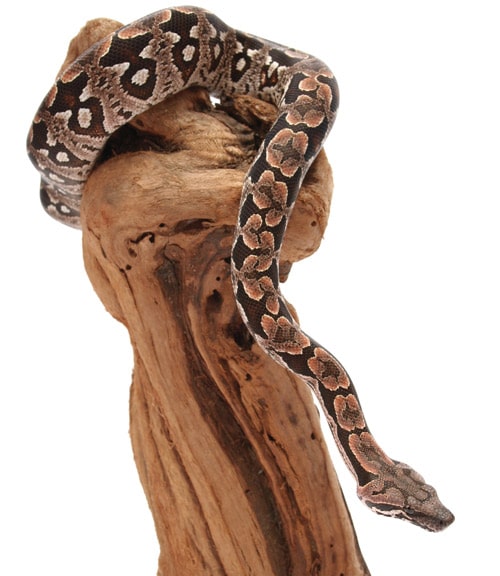Care sheet for the Dumeril’s boa (Boa dumerili).
Updated February 1, 2023
Dumeril’s Boa (Boa dumerili)
Dumeril’s boas are medium-sized snakes, very stocky in build and calm in temperament. Dumeril’s boas are clad in a variety of colors — peaches, tans, browns, grays, greens and reds. They come from the drier southwestern regions of Madagascar where rainfall is minimal (but not desertlike).
Dumeril’s boas make great pet snakes, but I would not recommend them as a first pet snake. With this care sheet, you will learn husbandry techniques and required snake supplies. Dumeril’s boas have calm dispositions and rarely attempt to bite. All bites I have experienced from Dumeril’s boas have been from overzealous feeding. I have never been bitten in an aggressive/defensive manner.
Dumeril’s Boa Availability
Dumeril’s boas are readily available. There are several morphs that will be available in the future. You can find Dumeril’s boas for sale on the Internet and through online reptile shop/breeder websites, reptile specialty stores, and reptile shows and expos.
Dumeril’s Boa Size and Life Span
Dumeril’s boas range in size from 3 to 6 feet. Snakes up to 9 feet long are rare, but they are out there. Neonate Dumeril’s boas range in size from 12 to 18 inches. Dumeril’s boas are slow-growing snakes that take 3 to 5 years to fully mature. Dumeril’s boas have been known to live for more than 20 years. The oldest Dumeril’s boa in my collection is 16 years old.
Dumeril’s Boa Caging and Substrate
Neonate Dumeril’s boas can be kept in 5 to 10 gallon glass reptile terrariums or in a shoebox- or sweaterbox-style rack system. Juvenile Dumeril’s boas up to about 3 feet in length can be kept in a glass, wood or plastic enclosure measuring 2 feet long by 2 feet deep by 14 inches tall. Adult Dumeril’s boas should be kept in enclosures measuring 4 feet long by 2 feet deep by 2 feet tall. Snake substrate for your enclosure can consist aspen shaving or cypress mulch. Do not use cedar or pine shavings! Cedar and pine can contain oils that can damage your snake’s skin and fumes that can lead to neurological issues.
Reptile Heating and Lighting
Dumeril’s boas do not require special lighting like a lot of lizards, turtles and tortoises do. You can use a light for viewing purposes, but it is not required. Simple reptile viewing lights are available in a large variety.
Average temperatures need to be in the low 80s Fahrenheit. Cool-end temperatures should be between 75 and 80 degrees. Hot-end temperatures should be no higher than 85 degrees. Also, keep your humidity levels between 40 and 60 percent – levels lower than 40 percent can lead to shedding issues, and levels higher than 60 percent can lead to respiratory issues. I prefer to use an undertank heat source for heating enclosures, as this will help keep your humidity up. Simply place the water bowl in the center of the enclosure and it will receive enough heat from the hot side of the enclosure to keep the humidity right where it needs to be.
Dumeril’s Boa Food and Water
Dumeril’s boas are opportunistic feeders. In the wild, they will eat just about anything they can — including live reptile food like mammals, birds and even lizards.
In captivity, Dumeril’s boas will thrive on commercially available rodents, rabbits or fowl. Most all Dumeril’s boas will eat frozen/thawed prey items. I feed my snakes a primary diet of frozen/thawed or live rats and rabbits. Occasionally I will feed them fowl. Some Dumeril’s boas are very shy feeders, and you may have to cover their enclosure and/or leave the room until the snake is finished eating.
Always offer your Dumeril’s boa a bowl of fresh water (use filtered tap water or bottled spring water). Dumeril’s boas consume large amounts of water at a time. The water will also be used for soaking (mostly leading up to shedding). I recommend that you change your snakes water out every day or every other day at the very least.
Dumeril’s Boa Handling and Temperament
Dumeril’s boas are very calm by nature. Some snakes are shy and prefer not to be handled. You will quickly discover how much handling your snake will tolerate. Dumeril’s boas that prefer not to be handled will be rather flighty and try to escape from you rather than be aggressive. I like to “hook train” all of my snakes (not just Dumeril’s boas). This method helps condition your snake to know when it is time to be handled and when it is time for food. “Hook training” takes patience, but is very rewarding in the long run.
“Hook training” is a technique that conditions the snake to recognize when it’s dinner time or handling time. If I intend on handling a snake, I will use my hook to gently nudge the snake’s side to get its attention. Then I will hook the snake and pull it to me, I pull about one third of the snake’s body outside of the enclosure before placing my hands on the snake. I use this method instead of just reaching in and grasping the snake to help prevent being bitten.
Pat Higdon is an auto mechanic by trade and herper by passion. He’s kept reptiles for more than 25 years and is a proud member of the Oklahoma City Herpetological Society. Higdon’s Herps can be found on Facebook.


